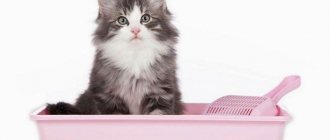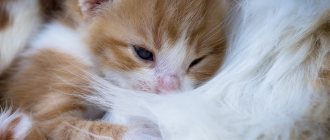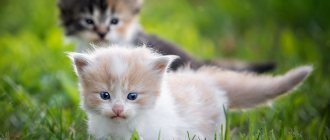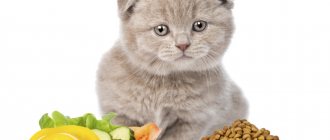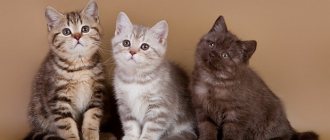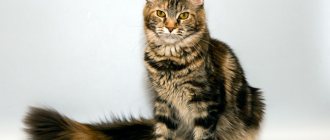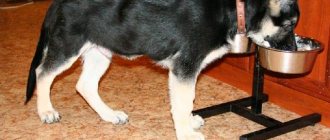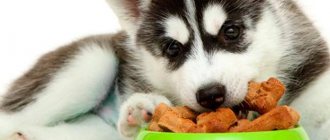How and what to feed a kitten? The first months of any animal’s life are accompanied by intensive growth of the entire organism. Genetics determines the body’s capabilities, but the extent to which these capabilities will be realized directly depends on the adequacy of the diet during the period of active growth and maturation. Any breeder knows that what is lost in the first months of life is subsequently impossible to make up.
A complete diet ensures not only the proper development of all systems and organs of the kitten, but also a sufficient level of immunity to resist diseases to which young animals are susceptible.
What is a “complete diet”?
Scientists zoologists involved in nutrition have calculated certain norms for the amount of energy and nutrients that an animal of a certain species, breed, age and sex should receive daily.
A complete diet is a diet that fully provides the animal’s body with all the substances necessary for life in the required quantity and ratio.
Based on knowledge about the nutritional needs of a kitten’s body, its physiological characteristics at a certain age and the chemical composition of food, approximate norms of a daily diet are calculated and a certain set of products is recommended for each age period of cats.
Reflex feeding: six months to a year
When they reach six months, kittens are already transferred to the category of teenagers who have practically gained the required weight and can now get used to adult food twice a day. If the plans include sterilization of the animal, then this should also be done before a year, after which feeding more than twice a day will generally be contraindicated, and the ideal option for such animals is one-time evening feeding.
It is very important during this period to accustom the kitten to a regular diet. To do this, try to remove the bowl after each feeding so that the baby learns to hunt and get food, and not lazily find it at the slightest whim. Then your future mustachioed friend will have a playful character and will also move a lot in adulthood. This will protect him from obesity.
Upon reaching six months, and for some breeds even earlier, the breeder should finally decide on the form of nutrition - will it be ready-made or natural food? It is equally important to choose the final manufacturer (if you plan to feed “dry” rather than “natural”) in order to begin to consistently accustom your pet to your preferences. If you do not establish eating habits at this age, after a year your pet will dictate terms to you.
When should you start complementary feeding and how many times should you feed your kitten per day?
Experts recommend introducing complementary foods into the diet with the appearance of the first milk teeth, at the age of 3-4 weeks.
In some cases, it is necessary to start complementary feeding earlier - the cat’s milk supply is low, mammary gland diseases, multiple births, when kittens do not have enough milk and they begin to lag in growth.
In order to know whether the kittens are receiving enough essential nutrients, you need to weigh them regularly, and if they fall behind, start feeding the kittens.
When controlling your weight, take into account the following standards:
- At birth, the average weight of a kitten is 100 g, plus or minus 20 g, which depends on heredity and breed.
- After about 10 days, the weight doubles, and subsequently increases by an average of 100 g per week.
- At two months, a large breed kitten should weigh on average 1100 g, plus or minus 200 g, while male cats weigh more than female cats.
It also happens that kittens are left without a mother and the owner has to take full charge of feeding.
Frequency of feeding kittens depending on age:
- In the first 14 days of life - 10 meals;
- From two weeks to one month, reduced to 8 meals;
- By two months they switch to feeding 7 times a day;
- From the 2nd to the 3rd month they feed 6 times;
- From 4 to 5 – 5 times;
- From 5 to 9 – 4 times;
- From 9 to 12 – 3 times;
- After a year they switch to two feedings a day.
In the case of artificial feeding, from birth to one month, kittens are also fed at night. The above norms are approximate, just as the interval between feedings is approximate; small kittens themselves will let you know when it’s time to feed them, showing concern.
Age 3-6 months
At this point, the kitten's teeth and jaws are fully formed. Therefore, you can forget about the grater. But you'll have to pick up a knife. Because pieces that are too large will only be slobbered on and thoroughly chewed, but they will never get into the kitten’s stomach.
But now you don’t have to necessarily cook the meat and vegetable components of the menu. Of course, you will still have to cook the porridge, because kittens do not eat raw cereals. Raw fish is added to the diet. Strictly sea and boneless. River fish is contraindicated!
The milk is completely removed. It is replaced with low-fat cottage cheese or fermented milk products. You can sometimes give egg whites, raw ones. But teenage kittens often become indifferent to eggs in general. But at this time, unexpected taste habits are formed. Therefore, it is very important now to diversify your pet’s menu as much as possible. Otherwise, he will get used to one product and simply ignore the rest.
By the way, there are many known cases when kittens after 3 months demanded completely non-cat products:
- corn
- honey
- chocolate
- raw potatoes
- sunflower seeds
- fresh cucumbers
- dried fruits
Every normal person understands that such nutrition does not contribute to the full development and good growth of a kitten. Some make excuses by feeding the fluffy another candy: “Well, he loves it! »
You never know who loves it! But cats also have diabetes, obesity, urolithiasis and other human diseases. And they do not arise on their own. Domestic cats are fed by humans, which means that it is he who is to blame for the pet’s illness.
Do you want to pamper your kitten? Give him a prohibited non-cat product. But very little and very rarely. Let it remain a delicacy or a reward, but not a permanent menu item.
Can it be given to kittens?
What products can be used to feed kittens if the owner prefers natural feeding for his cat?
Many foods that are acceptable in the diet of an adult animal are not recommended for kittens. This is explained by the fact that some foods are heavy for a fragile digestive system or carry a large amount of energy without satisfying the basic needs of a growing body.
The kitten’s diet should include foods that are as healthy as possible; they should be well digestible and not contain harmful substances.
Is it possible to give kittens milk?
The question implies: is it possible to give kittens what is familiar to us and most used by humans - cow's milk?
Cow's milk is not the best choice for feeding an early kitten. The composition of the milk of each species of animal is ideal for feeding its own young, but not suitable for the young of another species.
The composition and ratio of fats, carbohydrates, proteins and other chemical elements of cat and cow milk are different from each other. Cat's milk contains half the fat and 2.5 times more protein than cow's milk. It also differs in the ratio of proteins and the content of other, organic and inorganic chemical elements per unit volume.
Milk can be used in small quantities for feeding older kittens and feeding adult cats, as long as it does not cause digestive upset in the pet.
For small kittens from birth to 1 month, artificial cat milk is ideal; it can be purchased at pet stores.
Baby food (formula)
Can be used for artificial feeding of a newborn and feeding older kittens. When feeding with formulas, their concentration should be 2 times less than for children in the first week of life.
Dairy products:
Cottage cheese, sour cream, kefir, fermented baked milk, and cream are used to feed kittens in addition to meat, as a source of protein and calcium. Fermented milk products also improve the composition of microflora. You need to choose dairy products with minimal fat content.
Is it possible to give cheese?
Cheese is a healthy product, but it can be used occasionally as a treat - it contains a lot of fat.
Raw meat
It is not advisable to feed minced fish to kittens; before feeding, the fish must be boiled, and the meat either frozen or scalded.
Meat products form the basis of a kitten’s diet; preference should be given to veal, beef and chicken. You can feed lamb, rabbit meat, horse meat. It is not advisable to feed pork - it is too fatty.
Veal and beef can be used for feeding daily, choosing pieces without fatty inclusions. Give in the form of minced meat or scraps (from the beginning of complementary feeding to 7 weeks) and in the form of small pieces, no more than 1 cm, for older kittens.
If the meat is fresh, you can serve it raw, without any processing, or scald it with boiling water first.
It is better to give chicken meat boiled; raw meat may contain the causative agent of salmonellosis. You can feed it every other day.
Fish is given up to 2 times a week.
Liver
A valuable by-product, it is rich in B vitamins and iron. The liver contains a large amount of vitamin A. Kittens are given beef or chicken liver 2 times a month. In addition to the liver, it is also useful to feed other offal products - heart, kidneys, lungs. They are used more often - 2-3 times a week. Cats should not be fed spleen.
Raw or boiled egg
Use only the yolk, give it 1-2 times a week, adding it to cereals, vegetable purees or milk.
Cereals
Rice, oatmeal, semolina are used in the form of liquid porridges in milk without sugar (up to 3 months of age) or boiled in water, mixed with fish or meat: cereal - 1 part, meat - 2 parts.
Vegetables
They must be present in the diet in boiled or raw, pureed form. They are added to porridges, given mixed with yolk, meat or fish, several times a week.
Dry food
If you are an adherent of artificial nutrition, choose high-quality food for your kitten; experts do not recommend feeding kittens with food of classes lower than premium or super-premium. Start with food soaked in water. Monitor your kitten's water consumption - it should be of good quality and always available. Use dry food, alternating it with wet food from the same manufacturer, the ratio in the diet is 70% dry, 30% wet.
Food for adult cats should never be given to a kitten. Excessive doses of vitamins, macro- and microelements can lead to many negative consequences, from diseases of internal organs to poisoning with biologically active substances, which include vitamins.
When he doesn't eat on his own
If the kitten is still very small and cannot eat from a bowl on its own, then you should purchase a special bottle for feeding it. When there is none, you can use a pipette, a syringe or a piece of bandage twisted into a tourniquet. The message option is considered the worst, since there is a risk that the baby will swallow the thread, and this is dangerous.
Advice! Before the 5th day, kittens should be fed once every 2 hours around the clock, and from the 5th day - once every 3 hours and also around the clock. In the period from 2 to 3 weeks, only one feeding is needed at night, and during the day food is given once every 3 hours.
A small kitten is fed from a bottle
A special bottle with a nipple for feeding kittens, which can be purchased at a pet store or veterinary pharmacy, is the optimal solution. It is made in such a way that when sucking the baby will not swallow excess air, and the size of the nipple is optimal for the kitten’s mouth.
If feeding is carried out using a pipette and a syringe, then the rubber part of the pipette is pulled onto the nose of the syringe instead of the nipple. The baby will suck on it. It is unacceptable to pour in milk by force, since in this case, most likely, the baby will suffocate and choke.
When, as a last resort, a bandage is used, it is folded so as to minimize the risk of threads getting into the mouth. The resulting flagellum is dipped in milk and given to the pet to suck.
What to feed newborn kittens without a cat?
The best option is a cat milk replacer. If for some reason this is not possible, you can prepare a mixture similar in composition to cat milk according to the following recipes:
- Baby formulas. Milk is prepared twice as liquid as for a baby in the first week of life.
- For 100 ml of cow's milk add one chicken yolk, 7 ml of 5% glucose and 3 drops of tetravit.
- Dilute 5 ml of cream 10% fat with boiled water in a volume of 3 ml and add 2 ml of 5% glucose.
- Goat milk mixed with water.
How to teach your baby to eat and drink from a bowl
At a young age, animals often copy the behavior of more experienced relatives. Their main authority is their mother. If a cat shows interest in raising offspring, then she herself teaches him all the basic skills. Otherwise, the owner will have to figure out how to teach the kitten to eat on its own.
For bowl training, use the following tips:
- Separate the cubs from their mother 2 hours before feeding. This will help them work up an appetite.
- Pour warm milk (36 °C) into a tablespoon and offer your pet a try. You can also use a regular finger and dip it in milk.
- If your pet drinks or licks the milk offered, pour a new portion into his bowl. Perform actions right in front of your baby. Having seen and smelled familiar food, he will definitely show interest in the container.
- Don't poke the animal's nose. This can cause unpleasant associations due to the increased sensitivity of the organ. Also, sudden inhalation of liquid can cause aspiration pneumonia.
- If the pet refuses to lap, repeat the second step. Stick your finger in the bowl and offer to try it again. Here you need to be patient. Soon the baby will understand what they want from him and will begin to eat himself.
During the meal, stop attempts to climb into the bowl with all four paws. If you frequently turn the container over, choose a more stable model. Do not use detergents that have a strong odor. Accompany every trip to the kitchen with the word “eat”, reinforcing positive associations. At first, be sure to return the pet to its mother for additional feeding.
What should kittens not be given during their growth period?
- Cow's milk is not suitable for kittens; it does not provide the body's basic needs and is difficult to digest.
- Raw river fish – causes a lack of vitamin B and helminthic infestations.
- Fermented milk and dairy products with a high fat content.
- Fatty meats, pork.
- Sausages, smoked meats, products containing salt and spices.
- Potatoes and legumes are not digestible by cats; in addition, legumes cause fermentation in the intestines.
- Flour products and sweets do not bring any benefit to the body and contribute to excess weight gain.
- Chocolate is dangerous for cats and contains a substance that is toxic to this type of animal.
Further complementary feeding
So, time flies very quickly, and in a couple of months the kitten turned from a little fool into a charming playful creature. Now he needs more and more strength and energy, so his nutrition should be different, and a new product should be introduced weekly. They try to give boiled lean chicken, rabbit or turkey; low-fat sour cream, boiled beef liver, boiled fish or poached for a minute, separated from the bones. Boiled and chopped chicken or quail egg. Pumpkin puree with milk.
Any unfamiliar food should be given to a kitten in small doses and its behavior and well-being should be carefully observed. If the influence of a new bait negatively affects him, it is best to exclude him from the diet.
Consequences of poor nutrition
Poor nutrition, especially during the growth period, is the cause of many diseases and disorders:
- Stunted growth;
- Incorrect formation of the skeleton;
- Metabolic disorders;
- Reduced immunity;
- Allergic reactions;
- Poisoning;
- Worm infestations;
- Reproductive dysfunction.
Without following the basic rules and norms of feeding, it is impossible to raise a healthy animal that meets all the characteristics of the breed.
Possible problems
In addition to observing the norms and frequency of feedings, it is important to avoid prohibited foods. They can lead to disturbances in the gastrointestinal tract, accompanied by complete refusal of food. An animal left without food for a long time may die.
Refusal to eat
If feeding problems occur in newborns, they must be checked by a veterinarian. Pathological reasons for refusing food at such an early age include:
- hypothermia, that is, low body temperature;
- intrauterine infection with leukemia, chlamydia or other dangerous diseases;
- too low weight associated with pathologies of the placenta;
- any intrauterine development disorders;
- internal injuries;
- hemolysis of newborns, accompanied by the destruction of red blood cells by antibodies supplied with colostrum.
If the baby has always had a good appetite, but increasingly refuses to eat after the introduction of complementary foods, then the problem may lie in:
- Stress
. Separating from the mother too early and abruptly switching to new food is harmful for the animal.
- Allergies
. An allergic reaction is accompanied by rashes, hair loss, redness of mucous membranes and other alarming symptoms. To normalize the condition, the allergen is excluded from the diet.
- Gastrointestinal disorder
. If vomiting and diarrhea occur, have your pet checked at a veterinary clinic. In addition to the usual eating disorder, worms or other parasites may be found in the body.
- Incorrectly selected dishes
. The pungent smell of plastic and the presence of dirt are unacceptable for clean representatives of the cat family.
If any alarming symptoms appear, be sure to contact your veterinarian. Kittens are more vulnerable than adult pets, so any delay can cost them their lives.
Prohibited foods
The list of prohibited foods includes everything that appears on the human table: spices, pickles, smoked foods, fried foods, flour and sweets. You should also exclude:
- pork, often contaminated with worms and causing obesity;
- millet and pearl barley porridge, poorly digestible in the stomach;
- grapes (raisins) and mushrooms that can lead to poisoning;
- garlic and onions, which contribute to the development of anemia;
- sorrel, which causes an acute form of gastritis;
- any bones that injure the esophagus and intestines when swallowed;
- a family of legumes that cause increased gas formation.
Milk is removed from the diet by the age of one year. Closely monitor your pet's reaction to this product. If lactose intolerance develops earlier, then it is not necessary to wait a year. This condition is accompanied by severe bloating and diarrhea, so it is difficult to miss.
Features of feeding kittens of different breeds
Is there a difference in feeding cats of different breeds? There is no fundamental difference, all cats are carnivores and are adapted to eating animal food, but when feeding, they take into account the propensity of a particular breed to certain nutrition-related diseases, and adjust the diet based on this.
Feeding a British kitten
Cats of the British breed are not picky in their diet, but they love to eat, and therefore often suffer from obesity. The owner should pay attention to the kitten’s weight, starting from 6 months, when intensive growth ends; if the kitten becomes overweight, select a less high-calorie diet.
Accustom your kitten to less fatty foods from childhood and do not get carried away with carbohydrates (porridge). The diet should consist mainly of protein foods, with the presence of vegetables.
Cats of this breed have beautiful thick fur. To maintain it in good condition, use vitamins and microelements that contribute to the good condition of the coat.
British kittens have a tendency to constipation; for prevention, it is recommended to use 2 ml of petroleum jelly in the daily diet.
What to feed a Scottish kitten and what to feed a fold-eared kitten?
British, Scottish and Scottish Fold kittens differ little in appearance and their feeding habits are the same. Watch the calorie intake and do not overfeed the kitten.
What to feed a Maine Coon?
The diet should always contain meat and offal.
Occasionally you can give sea fish.
In addition, chicken or quail yolk and fermented milk products are given in small quantities and infrequently.
Don't forget about vegetables.
If you prefer to feed your kitten dry food, choose a high-quality food.
Maine Coon kittens should always have water in a deep and heavy bowl; they like to rake the surface of the water with their paw before drinking.
The increase in live weight per day should average 400 g.
Feeding the sphinx
Sphynx cats have a very sensitive digestive system. It is necessary to change food or introduce new products very carefully; this is always fraught with digestive upset with prolonged diarrhea. For the same reason, sphinxes often suffer from dysbacteriosis.
The rate of metabolic microbiological processes is very high, so they have high energy needs, that is, lack of appetite, this is not about the sphinx.
There is a tendency to allergic reactions to individual proteins in meat products.
You may get the impression that these cats are omnivores, because they are ready to taste anything that doesn’t fit well, including poorly edible objects. Therefore, the owner needs to keep an eye out and not leave all kinds of chemicals and detergents, garbage, food waste and small objects in the cat’s access area in order to avoid poisoning in the pet or ingestion.
Due to sensitive digestion, food selection must be careful. When feeding sphinxes, follow these rules:
- no treats from the table;
- If dry food is used for feeding, it should only be of high quality;
- Do not use dairy products after 3 months of age;
- The basis of the diet is a variety of lean meat products and all kinds of offal. Bones need to be removed;
- Boiled sea fish is given occasionally and if there are no signs of metabolic disorders and urolithiasis, in these cases it is completely excluded;
- Many breeders advise feeding cats of this breed only natural food.
The amount of feed and feeding regimen are individual and selected experimentally.
Feeding a Bengal kitten
Feeding kittens of this breed is no fundamentally different from feeding kittens of other breeds; follow the recommendations described above.
Veterinarian advice
For cats living in apartments, their daily routine is very important. The sooner a kitten gets used to receiving food at a certain time, the faster its digestive system will adapt to an adult diet. This is due to the fact that digestive enzymes will reach their maximum concentration strictly at the hour of feeding, which will have a positive effect on the absorption of food.
The place in which the pet is fed is chosen to be quiet and calm, where the kitten will not be in the aisle and will not be disturbed. Without this, against the backdrop of constant stress while eating, your pet may develop digestive problems, which will negatively affect its development and growth.
When there are several kittens in the house, their food bowls are placed in different places. This avoids competition for food that is unacceptable. If the kittens compete, then the weaker pets will remain hungry, and the stronger ones will begin to overeat. As a result, everyone's health will be harmed.
Nibelung cat breed, character and description
The kitten should only be given food at room temperature. Do not give hot food. It is unacceptable to expect that the baby will wait until it cools down. In most cases, the kitten will get burned and become afraid of the bowl, which will significantly complicate the feeding process. If the burn is severe, then treatment will also be required.
Ready-made food for kittens
Ready-made food is available in the form of dry food or wet food - jelly-like mousses, canned food and treats.
As already mentioned, if you do not want to risk your pet’s health, you need to choose premium and super premium food.
Cheaper feeds do not have high quality raw materials and may contain harmful preservatives and dyes, which, when used for a long time, affects the health of the animal.
To feed a kitten from 1 to 4 months, use wet mousses or dry croquettes, which are soaked in water. After 4 months, they switch to dry food; it is useful to combine it with wet food from the same manufacturer - mousses and canned food. Occasionally you can pamper an older kitten with treats.
Important! When feeding dry food, ensure the kitten has constant access to water.
Dry food for kittens
Among super-premium dry food, the following are deservedly popular:
"Royal Canin", "Purina ProPlan", "Iams/Eukanuba".
Premium dry food:
“Hills” (Hills), “Eagle Pack” (Eagle Pak), “Pro Pak” (Pro Pak), “Nutro Natural Choice” (Nutro Natural Choice).
Characteristics that you should pay attention to when selecting high quality feed:
- They do not contain soy, by-products, chemical dyes, preservatives, or odor imitators;
- Meat comes first in the description of the food composition;
- The number of additional ingredients is at least 4-5, usually 8 or more.
Solid food feeding
As soon as the kitten has its first sharp teeth, you can gradually give it other foods other than milk. There are no unusual products in this complementary food. It is very important that the animal's food is warm. You can feed him well-cooked oatmeal with the addition of hard-boiled egg yolk. Cottage cheese diluted with warm milk, it is advisable to grind it with a teaspoon until it becomes mushy. Ground beef, pour boiling water over it, or freeze it in the refrigerator for 2 days to kill some harmful bacteria.
Drinking regime
To digest solid food, more liquid is required, so with the introduction of complementary foods it is necessary to pay special attention to the drinking regime. Change the water in the bowl every day, and in the summer - 2 times a day. Otherwise, bacteria and other harmful microorganisms will accumulate in it.
Remember that animals can only be given bottled water from the store or filtered water. Tap water contains metals, salts and other dangerous deposits that can harm the body.
How to tell if your pet has enough food
The norms for the daily volume of food vary significantly and not always everything that is written on a pack of food suits the pet exactly. To find out, it is important to observe your pet for a while. As a rule, healthy kittens do not overeat. To know if your kitten has enough food, weigh it and refer to the weight described above. Also, do not forget to give the kitten the amount of food that is suitable for its age and weight, then there will be no problems. The kitten will always run around fed and well-fed.
A healthy kitten is the key to a happy life for both pet and owner
Weighing your pet
Kittens will gain weight daily. But to find out the exact weight indicators, it is important to go to the veterinarian and monitor the baby’s growth there.
Typically at 2 weeks, a kitten weighs about 170 grams.
At 2 months, the kitten's weight will reach 900 grams.
At 3 months, the baby, thanks to a proper diet and active lifestyle, will weigh 1400 grams.
By 4 months – 1800 grams.
Closer to six months, when the kitten is completely strong after birth, the weight will be about 2500 grams.
It is necessary to weigh your pet every day, at the same time, so that the indicators are accurate. To weigh your pet, you can use a kitchen scale as the most accurate option.
Weighing a kitten is an essential part of its daily life.
Basic rules of care
Of course, you no longer notice the features of your home, but a new, unknown world, full of fears and smells, opens up for your kitten. Therefore, many kittens experience a real stressful feeling when moving to a new place of residence. And your task is to brighten up the first minutes and days in which the kitten will settle into the house.
There is no need to force your friendship on the kitten or introduce it to other family members. Believe me, when the time comes, the pet will take a step forward. The only thing you need to do is introduce the baby to the bowl, tray and bed.
At first, the bed will become the only stronghold in the kitten’s life, so try to make it as comfortable as possible. You can buy a bed for a kitten in an online store or in a specialized market, and if you don’t want to spend money, you can set up a mini den yourself. The most ordinary cardboard box is suitable for this purpose. Lay a few warm clothes inside it, and for the first time this will be enough. Place the box in a warm, draft-free place. Happy parenting!
